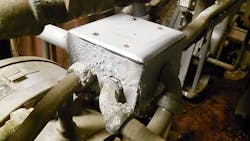How well do you know the Code? Think you can spot violations the original installer either ignored or couldn't identify? Here's your chance to moonlight as an electrical inspector and second-guess someone else's work from the safety of your living room or office. It's your turn to identify the violation.
Hint: Corrosion confusion
Find the Answer
The corrosion building up on the side of this box and all over the LFMC connectors is an indication that these materials may not be suitable for the environment in which they were installed. As you can clearly see in the photo, the side of the box is peeling right off.
This is a violation of Sec. 300.6. Unless this equipment is specifically identified for the use, Sec. 110.11 also prohibits equipment from being used in an operating environment that has a deteriorating effect on the equipment. Section 314.40(A) requires metal boxes and fittings to be corrosion resistant, well galvanized, enameled, or otherwise coated to prevent corrosion. Supplemental corrosion protection may be needed for this aluminum box and steel connectors. Perhaps nonmetallic boxes, connectors, and wiring methods may be better suited for preventing corrosion of this particular installation. In any case, the equipment grounding/bonding connections may be compromised if the corroded metal creates a high impedance path. This may also prevent the effective ground fault path required by Sec. 250.4(A)(3) and Sec. 250.4(A)(5) from being established. A shock and fire hazard would be created if the overcurrent device protecting this circuit was not able to quickly de-energize the faulty circuit because of these poor connections.





